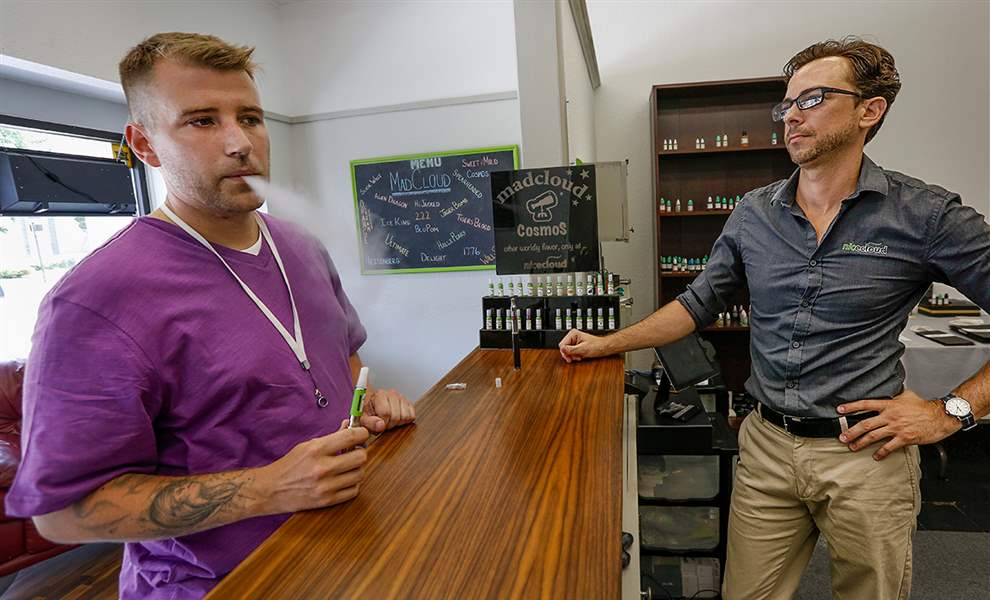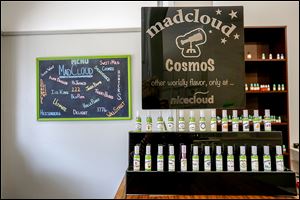
Ecigarette boutiques make case for the vapors
Proponents tout health benefits, but critics cite danger in nicotine ‘juices’
8/3/2014
Toledoan Joe Destazio tests various vapor flavors in the NiceCloud store.
THE BLADE/LORI KING
Buy This Image

Toledoan Joe Destazio tests various vapor flavors in the NiceCloud store.
Corrected version: Updated to reflect that vaping is not allowed at the University of Toledo.
When Tabitha Smorowski came downtown for a bottle of Hawaiian Punch, she didn’t want something to drink.
At the counter of NiceCloud Personal Vapor Devices, the Toledo woman bought a vial of liquid for her electronic cigarette that was intended to mimic the bright red beverage’s taste.
Ms. Smorowski, 41, used to smoke tobacco. Now she prefers inhaling fruit-flavored — and nicotine-spiked — vapor from her ecigarette. Ecigs produce the mist using rechargeable batteries that, when drawn, heat and vaporize the special liquid inside.
Users call the process “vaping,” after the white plumes of vapor users exhale. And Ms. Smorowski counts herself among the trend’s newest converts.
“I don’t want nothing to do with cigarettes anymore,” she said, waiting for her purchase. “They stink.”
Tobacco rules Ohio, where 23 percent of adults smoke cigarettes. The state currently has the fifth highest smoking rate in the country.
Those statistics prime Ohio for a booming ecigarette industry. Ecig proponents maintain that their products offer a healthy but convincing alternative to traditional cigarettes — a way for people like Ms. Smorowski to get their nicotine fix without the tar of Marlboros.
“We just really saw this as a way to save lives,” said Brad Everett, one of NiceCloud’s three co-owners. A former smoker himself, he began vaping four years ago, after watching Willie Nelson puff an ecig on Larry King Live.
The health benefits are clear, Mr. Everett said.

Various vapor flavors available at the Nicecloud e-cig store in Toledo.
Smoking tobacco made him hack and wheeze, but he can vape before the gym and “notice no difference” in his performance, he said.
NiceCloud, which opened in September at 913 Madison Ave., will debut a second Laskey Avenue location next week.
The pair of stores are just two of at least 25 vape shops throughout the area.
And more stores arrive at a steady clip:
■ Vapors, which operates a flagship location on Monroe Street, will come later this month to Port Clinton as part of seven-store expansion.
■ Cravin’ Vapes, on Dorr Street, held its grand opening Friday.
■ And the Crave Cave — which bills itself as a “vapor lounge,” with free WiFi and coffee, cool blue walls, and a fish tank of African cichlids — just opened a second storefront in Maumee.
“There is no specific demographic,” said J.P. Penn, 22, the manager of Crave Cave’s McCord Street location. “Everybody is vaping.”
Growth in the Toledo area mirrors national trends. The first commercial ecig hit the Chinese market in 2003 and came to America shortly afterward.
Now Wells Fargo analysts estimate the current market has grown to $2.2 billion, well above 2012’s $500 million in sales.

NiceCloud Personal Vapor Devices opened in September. There are at least 25 vape shops throughout the area.
Those figures reflect a large and increasingly diverse market. Vapes range from the cheap, disposable models readily found at gas stations to Swarovski-encrusted investment pieces available only at specialty stores. Ehookahs, epipes, and ecigars are also available.
Most shops focus on the middle to high end of the reusable market. Starter kits hover around $50, while bottles of liquid “juice” cost between $8 and $14.
Juices — a combination of vegetable glycerin, propylene glycol, liquid nicotine, and flavoring — offer one way for business owners to distinguish themselves from competitors.
Ambitious flavors like champagne, goji berry, and creamsicle line the walls of area vape shops.
Most shops offer tobacco flavors to attract struggling smokers. They also offer juices without any nicotine at all, for customers hoping to enjoy the taste but not the buzz of Vapors’ signature Chocolate Cake.
Juices, in particular, have drawn the ire of critics. In general, the newness of ecigarettes has befuddled medical consensus concerning their long-term effects.
But even small quantities of liquid nicotine are lethal, making juices the greatest definite danger of ecigs so far.
In the past several years, the Centers for Disease Control and Prevention has reported an uptick in cases of liquid nicotine poisoning. Groups like the Campaign for Tobacco-Free Kids also argue that candy-like flavors can entice kids to smoke.
These concerns, brought to light by vaping’s new-found popularity, have motivated regulators at all levels to examine ecigarette use.
Ohio House Bill 144, which goes into effect this week, is the only piece of statewide legislation concerning ecigarettes. The bill classifies ecigarettes as “alternative nicotine products” and forbids shops from selling them to children under 18, though many Toledo business owners said they already ID customers voluntarily.
Unlike New York City, which famously wove ecigarettes into its municipal indoor smoking ban, Ohio’s ban permits vaping. That means local institutions and attractions are free to allow or prohibit the practice as they please, often to dissonant effect.
One example: Ohio State, citing its campuswide tobacco ban, does not allow ecigarettes. Vaping is also not allowed at the University of Toledo.
Nationally, the Food and Drug Administration has proposed a series of sweeping regulations to govern ecigarette sales, which would add nationwide consistency to the existing patchwork of laws.
Suggestions range from restrictions on advertising to application and registration fees.
The industry welcomes some regulation, but business owners like Mr. Everett worry that proposals like the FDA’s could saddle small businesses like his with unaffordable fees. Such costs would threaten not only profits and businesses, he said, but an entire industry linked uniquely to social good.
“People like to smoke,” he said. “They’ve been smoking for hundreds of years, and that’s not going to change. To have this as an alternative, it’s a godsend.”
Contact Marissa Medansky at: mmedansky@theblade.com or 419-724-6368.